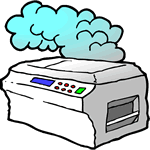
Introduction
|
Part 2
|
In Part I, you learned the basics of contacting a seller of a good or service with a complaint. When you contact a seller about a problem and it is resolved to your satisfaction, awesome! But not all problems are so easy to fix. If the seller won't do what you think it should, you are ready to take the next step–getting outside help. You will probably be surprised by how many different organizations are available to help consumers.
Task List
 In this lesson, you will read about some of the private organizations (besides the seller) that assist consumers with problems. You will then use this information to identify a source of help for a hypothetical marketplace dispute. You will also consider what incentives these organizations have for getting involved in consumer problems.
In this lesson, you will read about some of the private organizations (besides the seller) that assist consumers with problems. You will then use this information to identify a source of help for a hypothetical marketplace dispute. You will also consider what incentives these organizations have for getting involved in consumer problems.
Process
A wide variety of business, media and consumer groups have established programs to help consumers experiencing problems with goods and services.
Some of the key organizations that offer assistance to consumers are summarized below.
Better Business Bureaus
One of the places consumers most frequently identify as a source of help is the https://www.bbb.org/ . This network of nonprofit organizations supported by local businesses tries to resolve buyer complaints against sellers. A complaint can be filed by telephone, mail or the Internet. A Better Business Bureau (BBB) can suggest, but not force, a business to resolve a problem.
BBBs also keep files on complaints against local businesses and whether they were resolved. This information is available to future customers who want to know whether others have complained about a seller and how the seller responded. The umbrella organization for the BBBs helps settle disputes with automobile manufacturers through the BBB AUTO LINE program. BBBs do not charge for these services.
Media Programs
Local newspapers, radio stations, and television stations often have Action Lines or Hotline services that try to resolve consumer complaints filed via mail or telephone. They use news stories–and the threat of a news story—to resolve problems. Most businesses don’t want negative information in the news.
Consumer help from these programs is provided free of charge. To learn whether such a program serves your community, check with your local newspapers or broadcast stations. https://callforaction.org/ lists a nonprofit network of consumer hotlines affiliated with local broadcast partners.
Trade and Professional Groups
Sellers of similar products or services often belong to an industry or professional association. Because these special interest groups want to have a good public image, they sometimes establish business practice standards. They may also help resolve problems between their members and consumers. The organizations usually try to get a voluntary agreement between the consumer and business. A few groups have a process that is binding on the consumer, business or both. There is no fee for this service when it is available. The https://www.infoplease.com/business-finance/consumer-organizations/national-consumer-organizations identifies some of these groups. Your local librarian has reference materials that can help you find others.
A few industries have created special panels to resolve consumer complaints. For example, the National Automobile Dealers Association operates AUTOCAP – a free public service that tries to resolve disputes between consumers and auto dealers. For those tired of junk mail and e-mail spam, the Direct Marketing Association can help remove you from most mail lists.
Consumer Organizations
People sometimes form special interest organizations to focus on consumer issues and concerns. Some of these groups assist with complaints for free or at a low cost. Others may be unable to help individuals but are interested in hearing about problems that may influence their education and advocacy efforts. The https://www.infoplease.com/business-finance/consumer-organizations/national-consumer-organizations maintains a list of key national consumer organizations.
Using this Consumer Help worksheet, summarize the information you have just read concerning private organizations that offer assistance with consumer problems.
Conclusion
Some private organizations, such as the Better Business Bureau and Call for Action programs handle complaints about almost any type of good or service. Others groups can only help with certain types of consumer problems. 
Most resolutions sought by private groups are voluntary on the part of a business, though some trade and professional groups have ways to force members to respond to a problem.
Many consumer groups are limited to gathering information about problems versus taking action.
Assessment Activity
Your older brother just bought his first car. When he looked at the vehicle at the auto dealership, he noticed a small oil leak. He decided to purchase the car after the auto salesman agreed to fix the leak. Just one month later, your brother’s car breaks down and leaves him stranded on the highway. He has to pay $80 to have the car towed to an auto repair shop. The mechanic tells him there is now a major oil leak. It will cost $600 to fix the leak and the damage the leak caused. Your brother is furious—the auto dealer did not properly fix the leak! To make the situation even worse, your brother does not have the cash to fix the car and he does not have a car to get to work. When he calls the salesman who sold him the car, the salesman doesn’t remember promising to fix an oil leak. Your brother then calls the manager of the dealership who says the car was sold “as is” and refuses to take any responsibility for the repairs or cost of the tow. What would your recommend your brother do next?
Identify a private outside organization that you think could help.
Answer the questions on the interactive below, using the private outside organization you have chosen to resolve the problem in the example above.
-
How should your brother contact this organization (personal visit, telephone, letter)?
-
What is the address and phone number for the organization?
-
What is a reasonable request for resolving the problem?
- What type of help can your brother expect from the organizations?
Extension Activity
- Search local media sources–-newspapers, television and radio–for services that help consumers. Report what these programs can and can't do to help solve consumers' problems.
- An increasingly common way in which businesses try to settle disagreements is through dispute resolution programs. Research two types: mediation and arbitration. How are they the same? How are they different? A Venn diagram is a useful tool for this purpose. What advice would you give to someone considering one of these programs as a means to resolve a problem?
|
Part 2
|

